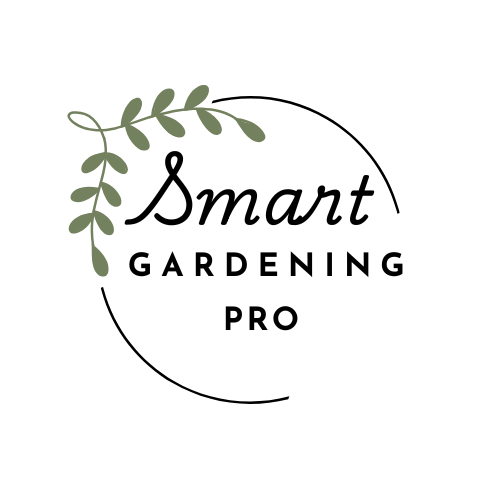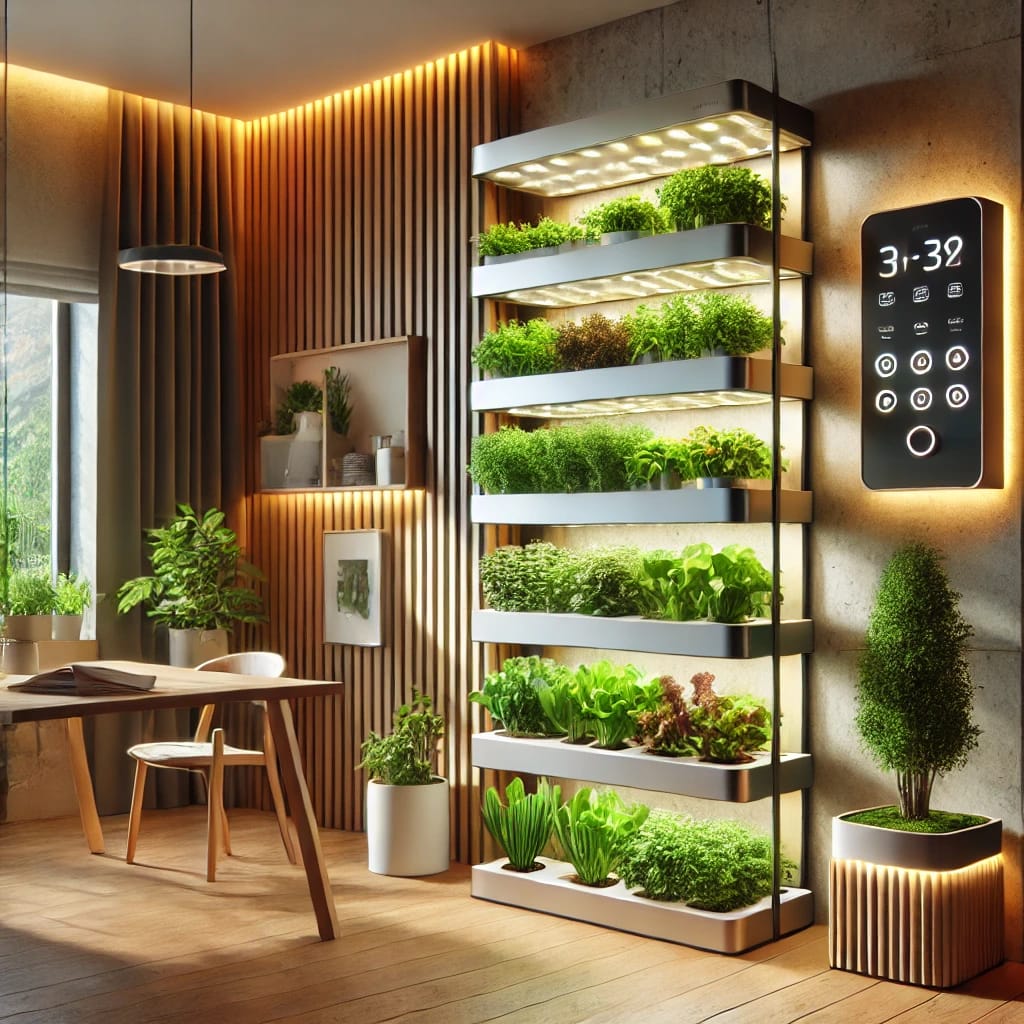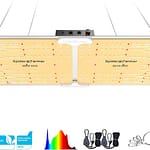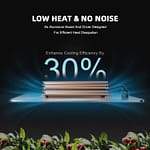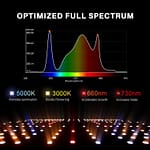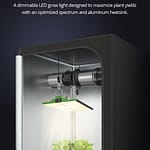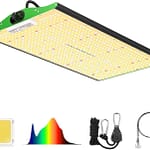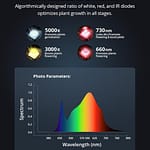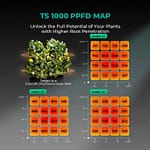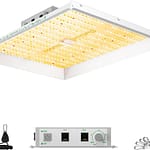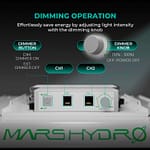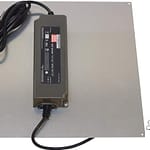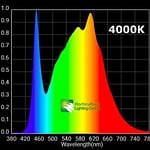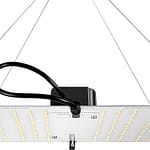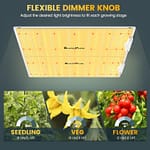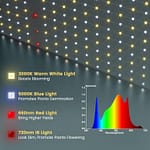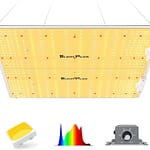Indoor gardening has transformed how we cultivate plants, allowing us to grow various species year-round, regardless of outdoor conditions.
This comprehensive guide explores the 5 best LED lighting systems for growing plants indoors, no matter where you live.
Table of Contents
- 1 The Evolution of Indoor Grow Lights
- 2 1. Spider Farmer SF-2000 LED Grow Light
- 3 2. VIPARSPECTRA P2000 LED Grow Light
- 4 3. Mars Hydro TS 1000W LED Grow Light
- 5 4. HLG 100 V2 4000K 95W LED Quantum Board Grow Light
- 6 5. BLOOM PLUS XP3000 LED Grow Light
- 7 Choosing the Right LED Grow Light
- 8 Maximizing Your LED Grow Light’s Potential
- 9 The Future of LED Grow Lights
- 10 People Also Asked
- 10.1 What is the best LED grow light for beginners?
- 10.2 How many watts do I need for a 4×4 grow tent?
- 10.3 Can LED grow lights burn plants?
- 10.4 Do I need special LED bulbs for growing plants?
- 10.5 How long should LED grow lights be on per day?
- 10.6 Can I use LED grow lights for seedlings?
- 10.7 Do LED grow lights use a lot of electricity?
- 10.8 Are full-spectrum LED lights better for plants?
- 10.9 How close should LED grow lights be to plants?
- 10.10 Can I leave my LED grow light on 24/7?
- 11 Key Takeaways
The Evolution of Indoor Grow Lights
Before we dive into our top picks, it’s crucial to understand how LED technology has changed the game for indoor growers. Traditional grow lights, such as High-Pressure Sodium (HPS) and Metal Halide (MH) lamps, have been the industry standard for decades.
However, these older technologies come with significant drawbacks, including high energy consumption, excessive heat output, and limited spectral customization.
LED grow lights offer numerous advantages over traditional lighting systems:
Energy Efficiency: LEDs convert a higher percentage of electricity into usable light for plants, significantly reducing energy costs. This efficiency translates to lower electricity bills and a smaller carbon footprint for growers.
Spectral Customization: Unlike traditional bulbs, LEDs can be engineered to produce specific light wavelengths optimal for plant growth. This allows growers to tailor the light spectrum to different growth stages or plant species, maximizing photosynthetic efficiency.
Lower Heat Output: LED lights generate much less heat compared to HPS or MH lamps. This allows for closer placement to plants and reduces the need for additional cooling systems, which can be a significant cost-saving factor in larger grow operations.
Longevity: High-quality LED fixtures can last 50,000 hours or more, far outlasting traditional bulbs. This extended lifespan means less frequent replacements and lower long-term costs for growers.
Compact Design: LEDs allow for sleek, space-saving designs ideal for small grow spaces or vertical farming setups. This compact nature enables growers to maximize their available space and potentially increase yield per square foot.
Now, let’s explore the cream of the crop in LED grow light technology.
1. Spider Farmer SF-2000 LED Grow Light
The Spider Farmer SF-2000 has quickly become a favorite among both hobbyist and professional growers. It’s full-spectrum white light, supplemented with 660nm red and 760nm infrared, provides plants with a light recipe that closely mimics natural sunlight.
Key Features:
- Samsung LM301B diodes for high efficiency (2.7 μmol/J)
- Dimmable driver with 0-100% adjustment
- Coverage area: 3×4 ft for flowering, 4×5 ft for veg
- Fanless design for silent operation
Pros:
The SF-2000 boasts excellent PPFD (Photosynthetic Photon Flux Density) output, promoting robust plant growth across various stages. It’s energy efficiency is a standout feature, with minimal heat generation allowing for closer placement to plants without risk of heat stress.
The silent operation of this light makes it perfect for home use, especially for growers who keep their setups in living spaces or bedrooms. The lack of fan noise can significantly improve the overall growing experience.
Pricing for the SF-2000 is competitive, especially considering the quality and performance it offers. This makes it an attractive option for growers looking to maximize yield without breaking the bank.
Cons:
One potential drawback of the SF-2000 is the lack of UV in it’s spectrum. While not essential for all plants, some growers prefer lights that include UV for potential benefits in trichome production and pest resistance.
The control features of the SF-2000 are relatively basic compared to more advanced models. Growers looking for sophisticated scheduling or spectral control might find the options limited.
Why Choose the SF-2000:
The Spider Farmer SF-2000’s balanced spectrum and high efficiency make it an excellent choice for growers looking to maximize yield in a variety of indoor growing scenarios. It’s silent operation is a significant advantage for those growing in living spaces or bedrooms, while its competitive pricing makes it accessible to a wide range of growers.
2. VIPARSPECTRA P2000 LED Grow Light
VIPARSPECTRA has built a reputation for offering high-performance lights at accessible price points. The P2500 continues this tradition with it’s impressive specs and versatile performance.
Key Features:
- Full spectrum with enhanced 660nm red and 3000K warm white
- Samsung LM301B diodes and high-efficiency driver (2.8 μmol/J)
- Dimmable from 5% to 100%
- Coverage area: 3×3 ft for flowering, 4×4 ft for veg
- Daisy-chain capability
Pros:
The P2500 shines in it’s light uniformity across the coverage area. This even distribution ensures that all plants receive consistent light intensity, promoting uniform growth and preventing “hot spots” or shadowed areas in your grow space.
With an efficiency rating of 2.8 μmol/J, the P2500 is highly energy-efficient, translating to lower electricity costs over time. This efficiency doesn’t come at the cost of performance, as the light still delivers impressive PPFD levels for robust plant growth.
Like the SF-2000, the P2500 operates silently, making it an excellent choice for home growers or those with noise constraints. The lack of fan noise contributes to a more pleasant growing environment.
The P2500 offers great value for money, delivering professional-grade performance at a price point that’s accessible to hobbyist growers. This combination of quality and affordability makes it a popular choice across various skill levels.
Cons:
The P2500 lacks UV and IR in it’s spectrum. While not essential for all plants, some growers prefer lights that include these wavelengths for potential benefits in plant development and flowering.
Like many lights in it’s class, the P2500 has limited advanced control features. Growers looking for sophisticated scheduling or spectral control might find the options somewhat basic.
Why Choose the P2500:
The VIPARSPECTRA P2500’s ability to daisy-chain many units makes it an excellent choice for growers looking to expand their setup over time. This feature allows for easy scaling of your grow operation without the need for additional power outlets or complex wiring.
The balanced spectrum of the P2500 is particularly well-suited for leafy greens and herbs. These plants thrive under the full-spectrum white light with enhanced red, promoting lush growth and potentially improving flavor profiles.
3. Mars Hydro TS 1000W LED Grow Light
Mars Hydro has long been a trusted name in the grow light industry, and the TS 1000W showcases why. This compact powerhouse delivers impressive performance in a sleek, user-friendly package.
Key Features:
- Full spectrum white light with added 660nm red
- High-efficiency SMD LEDs (2.5 μmol/J)
- Dimmable from 0-100%
- Coverage area: 3×3 ft for flowering, 4×4 ft for veg
- Fanless design with aluminum heat sink
Pros:
The TS 1000W boasts a compact and lightweight design, making it easy to install and maneuver in tight spaces. This feature is particularly useful for growers with limited headroom or those who frequently adjust their light setup.
Heat dissipation is excellent in the TS 1000W, thanks to it’s aluminum heat sink design. This effective cooling system allows the light to operate at optimal temperatures without the need for noisy fans, contributing to a quieter grow environment.
One of the most attractive aspects of the TS 1000W is it’s affordable price point. Mars Hydro has managed to pack impressive performance into a budget-friendly package, making it an excellent option for new growers or those looking to expand their setup without a significant financial investment.
The TS 1000W’s user-friendly design and performance make it suitable for both beginners and experienced growers. It’s straightforward operation and reliable output allow novices to achieve good results, while it’s efficiency and coverage area satisfy the needs of more seasoned cultivators.
Cons:
With an efficiency rating of 2.5 μmol/J, the TS 1000W is slightly less effective compared to top-tier models like the Spider Farmer SF-2000 or VIPARSPECTRA P2500. While still energy-efficient, growers with large setups might notice a difference in electricity costs over time.
Like many lights in it’s class, the TS 1000W lacks UV and IR in it’s spectrum. While not essential for all plants, some growers prefer lights that include these wavelengths for potential benefits in plant development and flowering.
Why Choose the TS 1000W:
The TS 1000W’s combination of performance and affordability makes it an excellent entry point for new growers or those looking to upgrade from fluorescent systems. It’s compact design is particularly well-suited for grow tents and small spaces, allowing growers to maximize their available area.
The full-spectrum white light with added 660nm red provides a balanced light recipe suitable for various plant species and growth stages. This versatility makes the TS 1000W a good all-around choice for growers cultivating many plant types or those who frequently switch between vegetative and flowering stages.
4. HLG 100 V2 4000K 95W LED Quantum Board Grow Light
Horticulture Lighting Group (HLG) has built a reputation for producing some of the highest quality LED grow lights on the market. The 100L V2 is a prime example of their commitment to excellence.
Key Features:
- Full spectrum white light with enhanced 660nm red (3000K + 660nm)
- Samsung LM301H diodes for high efficiency (2.8 μmol/J)
- Dimmable driver with external dimming knob
- Coverage area: 3×3 ft for flowering, 4×4 ft for veg
- Passive cooling system for silent operation
Pros:
The 100L V2 stands out for it’s premium build quality and components. HLG uses top-tier Samsung LM301H diodes, known for their high efficiency and longevity.
This attention to quality translates to reliable performance and a longer lifespan for the light.
Light penetration and canopy coverage are excellent with the 300L V2 Rspec. The combination of high-quality diodes and well-designed optics ensures that light reaches lower parts of the plant canopy, promoting even growth and potentially increasing overall yield.
With an efficiency rating of 2.8 μmol/J, the 300L V2 Rspec is highly energy-efficient. This efficiency, coupled with it’s low heat output, allows for optimal plant growth while keeping electricity costs and heat management concerns to a minimum.
The passive cooling system of the 100L V2 ensures silent operation, making it ideal for home growers or those with noise constraints. The absence of fans also means fewer moving parts that could potentially fail over time, contributing to the light’s overall reliability and longevity.
Cons:
The HLG 100L V2 comes with a higher price tag compared to some other options on this list. While the premium components and performance justify the cost for many growers, it may be a significant investment for hobbyists or those on a tight budget.
Like many lights in its class, the 100L V2 lacks UV and IR in its spectrum. While not essential for all plants, some growers prefer lights that include these wavelengths for potential plant development and flowering benefits.
The control features are relatively basic compared to some high-end models. Growers looking for sophisticated scheduling or spectral control might find the options somewhat limited.
Why Choose the HLG 100L V2:
While the HLG 100L V2 comes with a higher price tag, it’s superior build quality and performance make it a worthwhile investment for serious growers. The combination of high-efficiency Samsung diodes and thoughtful design results in a light that delivers consistent, high-quality results.
It’s particularly well-suited for flowering plants and those requiring high light intensity. Its enhanced 660nm red light promotes robust flowering and can potentially increase yield in many plant species.
This light offers significant advantages for growers focused on maximizing output, especially in the flowering stage.
5. BLOOM PLUS XP3000 LED Grow Light
Rounding out our top 5 is the Bloom Plus XP3000, a high-powered unit that offers excellent coverage and versatility for larger grow operations.
Key Features:
- Full spectrum with enhanced 660nm and 760nm IR
- Samsung LM301B diodes and MEANWELL driver (2.8 μmol/J)
- Dimmable from 0-100% with external dimming knob
- Coverage area: 4×4 ft for flowering, 5×5 ft for veg
- Fanless design with effective heat dissipation
Pros:
The BXP3000 boasts a large coverage area, making it suitable for bigger grows. Its ability to effectively cover a 4×4 ft area during flowering and a 5×5 ft area during vegetation allows growers to maximize their space efficiency and potentially increase overall yield.
With an efficiency rating of 2.8 μmol/J and high PPFD output, the BP3000 delivers impressive performance. This combination of efficiency and power ensures that plants receive enough light for robust growth while keeping energy costs manageable.
The inclusion of 760nm IR (infrared) light in the XP3000’s spectrum can be particularly useful for flowering plants. IR light has been shown to potentially improve flowering responses and increase overall yield in some plant species.
Despite it’s high output, the XP3000 is competitively priced for its class. This makes it an attractive option for growers looking to scale up their operations without breaking the bank on lighting equipment.
Cons:
The larger size of the XP3000 may not be suitable for small grow spaces or setups with limited headroom. Growers with compact tents or cabinets should carefully consider their space constraints before opting for this model.
While the XP3000 includes IR in it’s spectrum, it lacks UV light. Some growers prefer lights that offer both UV and IR for a more finished light recipe.
Like many lights in its class, the XP3000 has relatively basic control features. Growers looking for advanced scheduling or spectral control options might find the functionality somewhat limited.
Why Choose the XP3000:
The Bloom Plus XP3000’s large coverage area and high output make it an excellent choice for growers looking to maximize yield in larger spaces. It’s ability to effectively cover a 4×4 ft flowering area or a 5×5 ft vegetative area allows for effective use of grow space, potentially increasing overall productivity.
The inclusion of IR light in the XP3000’s spectrum can be beneficial for flowering plants. IR light has been associated with improved flowering responses and potentially increased trichome production in some species.
This added spectral component could provide a significant advantage for growers focused on maximizing yield and quality in the flowering stage.
Choosing the Right LED Grow Light
Selecting the ideal LED grow light for your indoor garden involves considering several key factors:
Grow Space Size
The size of your growing area is a crucial consideration when choosing an LED grow light. Measure your grow space carefully and match it to the light’s coverage area specifications.
Remember that most lights have different coverage areas for vegetative and flowering stages, with flowering typically requiring more intense light over a smaller area.
For example, if you have a 4×4 ft grow tent, you’ll want a light that can effectively cover that area during the flowering stage. The Bloom Plus XP3000 would be a good fit for this scenario, while the Spider Farmer SF-2000 might be better suited for a slightly smaller space.
Plant Type
Different plant species have varying light intensity and spectrum requirements. Leafy greens and herbs generally need less intense light compared to fruiting plants or flowering species.
Research the specific needs of your chosen plants to ensure your light can meet their requirements.
For instance, if you’re primarily growing leafy greens, the VIPARSPECTRA P2000 with it’s balanced full-spectrum output could be an excellent choice. On the other hand, if you’re focusing on flowering plants with high light requirements, the HLG 100L V2 Rspec with it’s enhanced red spectrum might be more suitable.
Growth Stage
The light needs of plants change as they progress through different growth stages. Seedlings and young plants generally need less intense light, while plants in the vegetative and flowering stages need more powerful illumination.
Many of the lights we’ve discussed, such as the Mars Hydro TS 1000W, offer dimming capabilities. This feature allows you to adjust the light intensity as your plants grow, providing optimal lighting conditions throughout their life cycle.
Budget
When considering your budget for LED grow lights, it’s important to think beyond the initial purchase price. Factor in long-term costs such as energy consumption and potential bulb replacements.
While a light like the HLG 300L V2 Rspec may have a higher upfront cost, it’s energy efficiency and longevity could result in lower overall costs in the long run. On the other hand, if you’re just starting out or working with a tight budget, a light like the Mars Hydro TS 1000W offers good performance at a more accessible price point.
Heat Management
Even though LED lights generate less heat than traditional grow lights, they still produce some heat that needs to be managed. Consider your grow space’s ventilation and cooling capabilities when choosing a light.
Lights with passive cooling systems, like the Spider Farmer SF-2000 or the HLG 300L V2 Rspec, can be useful in situations where minimizing additional heat is crucial. However, ensure that your grow space has adequate air circulation to prevent heat buildup, especially with higher-powered lights.
Maximizing Your LED Grow Light’s Potential
To get the most out of your LED grow light:
Adjust Height
Start with the manufacturer’s recommended hanging height and adjust based on plant response. The optimal height can vary depending on the light’s intensity and your plants’ needs. Watch for signs of light stress (such as leaf curling or bleaching) or stretching (indicating insufficient light) and adjust accordingly.
Monitor PPFD
Use a PAR (Photosynthetically Active Radiation) meter to ensure your plants are receiving optimal light intensity. PPFD (Photosynthetic Photon Flux Density) measurements can help you fine-tune your light’s position and intensity for optimal growth.
Implement Light Training
Techniques like LST (Low Stress Training) can help maximize light exposure across your canopy. By gently bending and securing branches, you can create a more even canopy that utilizes light more efficiently.
This can lead to increased yield and more consistent growth across all your plants.
Supplement with CO2
In high-light environments, additional CO2 can significantly boost plant growth. Plants can use more light when CO2 levels are increased, potentially leading to faster growth and higher yields.
However, CO2 supplementation needs careful management and is generally more suitable for sealed grow environments.
Maintain Proper Environment
Optimal temperature and humidity levels are crucial for plants to efficiently use the light provided. Most plants prefer temperatures between 70-85°F (21-29°C) and relative humidity levels between 40-70%, depending on their growth stage. Proper environmental control allows plants to photosynthesize efficiently and make the most of the light they receive.
The Future of LED Grow Lights
As LED technology continues to advance, we can expect to see even more effective and customizable grow lights in the future. Some exciting developments on the horizon include:
Adaptive Spectrum Technology
Future LED grow lights may automatically adjust their spectrum based on plant growth stage and species. This could involve sensors that watch plant health and growth, automatically tweaking the light spectrum to improve photosynthesis and other plant processes.
Integration with AI and IoT
Smart grow lights that can be controlled remotely and learn from data to improve growth are likely to become more prevalent. These systems could combine with other smart garden devices to create a fully automated growing environment, adjusting light, nutrients, and environmental conditions based on real-time plant needs.
Improved Efficiency
As LED technology advances, we can expect even higher μmol/J ratings, further reducing energy costs. This increased efficiency could make indoor growing even more accessible and sustainable, potentially changing urban agriculture and food production.
Specialized Spectra
Lights designed to enhance specific plant traits, such as flavor profiles in culinary herbs or medicinal compounds in cannabis, may become more common. These specialized lights could allow growers to fine-tune their crops for specific purposes, opening up new possibilities in plant cultivation.
People Also Asked
What is the best LED grow light for beginners?
For beginners, the Mars Hydro TS 1000W is an excellent choice. It offers good performance at an affordable price point and it’s easy to use.
How many watts do I need for a 4×4 grow tent?
For a 4×4 grow tent, you typically need between 500-650 watts of actual power drawn from an LED grow light for optimal results. You can see one of our recommended grow tents here.
Can LED grow lights burn plants?
Yes, LED grow lights can burn plants if they’re too close or too intense. Always follow the manufacturer’s recommendations for hanging height and watch your plants for signs of light stress.
Do I need special LED bulbs for growing plants?
Regular LED bulbs aren’t optimized for plant growth. It’s best to use LED grow lights specifically designed for plants, as they provide the right spectrum and intensity for photosynthesis.
How long should LED grow lights be on per day?
Most plants do well with 16-18 hours of light during the vegetative stage and 12 hours during the flowering stage. However, this can vary depending on the specific plant species.
Can I use LED grow lights for seedlings?
Yes, LED grow lights are excellent for seedlings. Start with the light at a higher distance and lower intensity, gradually lowering and increasing as the seedlings grow.
Do LED grow lights use a lot of electricity?
LED grow lights are generally very energy-efficient compared to traditional grow lights. However, the exact electricity usage depends on the wattage and how long you run them each day.
Are full-spectrum LED lights better for plants?
Full-spectrum LED lights are generally considered better as they provide a range of wavelengths that mimic natural sunlight, supporting all stages of plant growth.
How close should LED grow lights be to plants?
The optimal distance varies depending on the light’s intensity and the plant’s needs. Generally, start with 24-36 inches for seedlings, 18-24 inches for vegetative growth, and 12-18 inches for flowering.
Can I leave my LED grow light on 24/7?
While some plants can tolerate 24/7 light, most benefit from a dark period. Continuous light can stress plants and disrupt their natural growth cycles.
Key Takeaways
- LED grow lights offer significant advantages over traditional grow lights in terms of energy efficiency, spectral customization, and longevity.
- The top 5 LED grow lights we’ve explored cater to a range of growing needs and budgets, from compact units for small spaces to high-output lights for commercial operations.
- When choosing an LED grow light, consider factors such as grow space size, plant type, growth stage, and budget.
- Proper implementation, including correct hanging height and environmental control, is crucial for maximizing the benefits of LED grow lights.
- The future of LED grow light technology promises even greater efficiency and customization, potentially changing indoor agriculture.
